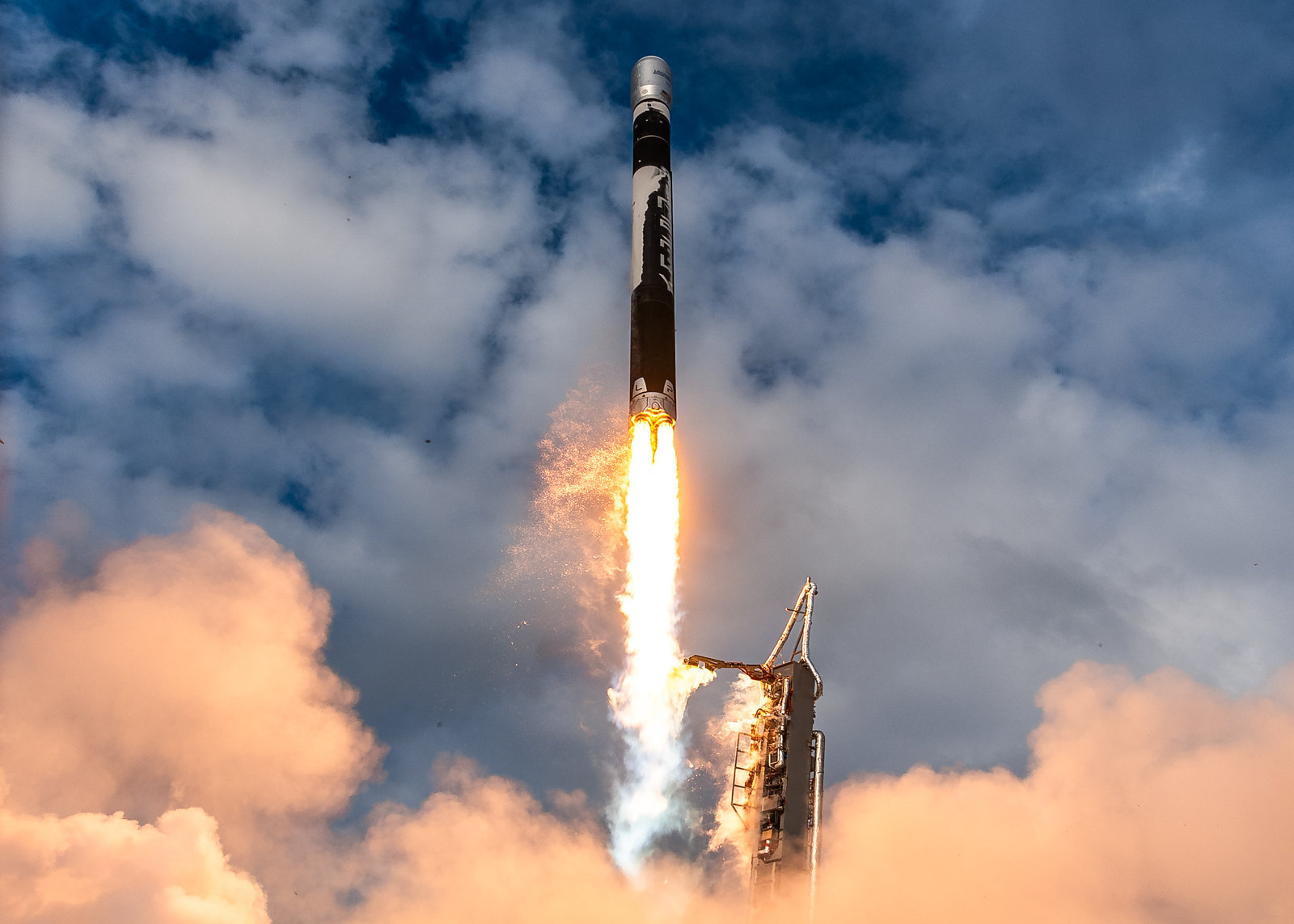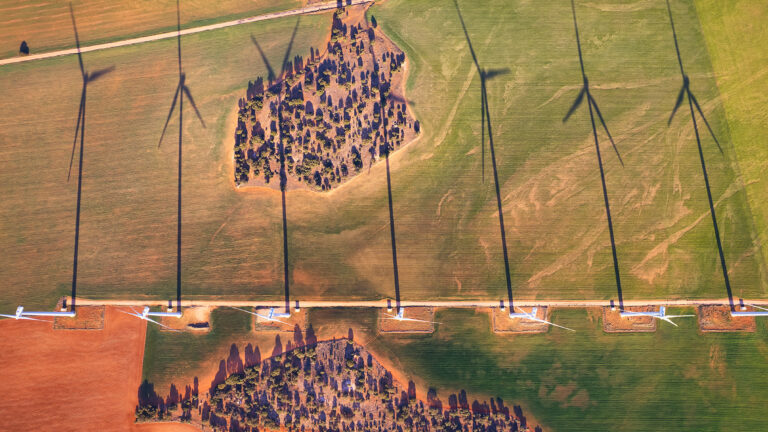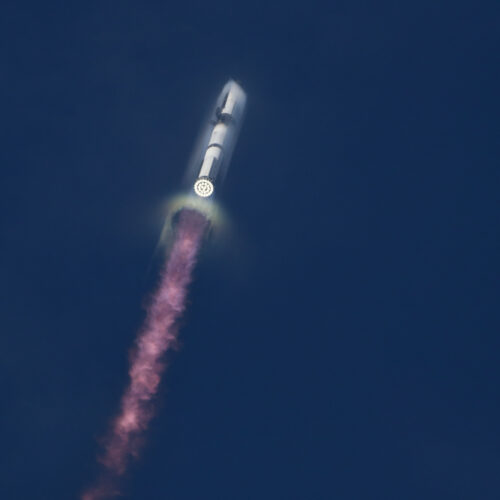The rocket’s first stage may have exploded moments after it separated from the upper stage.
Firefly Aerospace’s Alpha rocket on its launch pad at Vandenberg Space Force Base, California. Credit: Jack Beyer/Firefly Aerospace
Firefly Aerospace launched its two-stage Alpha rocket from California early Tuesday, but something went wrong about two-and-a-half minutes into the flight, rendering the rocket unable to deploy an experimental satellite into orbit for Lockheed Martin.
The Alpha rocket took off from Vandenberg Space Force Base about 140 miles northwest of Los Angeles at 6:37 am PDT (9:37 am EDT; 13:37 UTC), one day after Firefly called off a launch attempt due to a technical problem with ground support equipment.
Everything appeared to go well with the rocket’s first-stage booster, powered by four kerosene-fueled Reaver engines, as the launcher ascended through fog and arced on a southerly trajectory over the Pacific Ocean. The booster stage jettisoned from Alpha’s upper stage two-and-a-half minutes after liftoff, and that’s when things went awry.
A blast from below
A bright cloud of white vapor appeared high in the sky, indicating an explosion, or something close to it. A moment later, the upper stage’s single Lightning engine ignited for a six-minute burn to accelerate into orbit.
A ground-based infrared camera caught a glimpse of debris in the wake of the upper stage, and then Firefly’s live video stream switched to a camera onboard the rocket. The rear-facing view showed the Lightning engine stripped of its exhaust nozzle but still firing. Shards of debris were visible behind the rocket, but the video did not show any sign of the discarded first stage booster, which was expected to fall into the Pacific south of Vandenberg.
The upper stage engine kept firing for more than six minutes, when it shut down and Firefly announced that the rocket reached orbit. The rocket was programmed to release its single payload, a nearly 2-ton technology demonstration satellite built by Lockheed Martin, approximately 13 minutes into the mission. Firefly ended its live webcast of the launch before confirming separation of the satellite.
A short time later, Firefly released a statement acknowledging a “mishap during first stage separation… that impacted the Stage 2 Lightning engine nozzle.” As a result, the rocket achieved an orbit lower than its target altitude, Firefly said. The privately held Texas-based launch company amended its statement later Tuesday morning to remove the clause about the lower-than-planned orbit.
Another update from Firefly early Tuesday afternoon confirmed the launch failed. The company said the rocket “experienced a mishap between stage separation and second stage ignition that led to the loss of the Lightning engine nozzle extension, substantially reducing the engine’s thrust.”
The launcher reached an altitude of nearly 200 miles (320 kilometers) but did not reach orbital velocity, according to Firefly.
“The stage and payload have now safely impacted the Pacific Ocean in a cleared zone north of Antarctica,” Firefly said. “Firefly recognizes the hard work that went into payload development and would like to thank our mission partners at Lockheed Martin for their continued support. The team is working closely with our customers and the FAA to conduct an investigation and determine root cause of the anomaly.”
While Firefly’s live video of the launch lacked a clear, stable view of first-stage separation, the appearance of white vapor is a sign that the rocket was likely emitting propellant. It wasn’t immediately obvious whether the first stage recontacted the upper stage after separation or if the booster exploded and harmed the upper stage engine.
You can watch a replay of Firefly’s stage separation below.
Whatever the case, it’s an interesting mode of failure. Maybe it’s not as bizarre as Astra’s sideways launch in 2021, something every rocket geek should know about. Also, there’s the time Astra’s upper stage launched itself through a half-open payload fairing in 2022. United Launch Alliance’s Vulcan rocket lost a nozzle from one of its solid rocket boosters on a test flight last year, but the launch vehicle persevered and continued its climb into orbit.
The third flight of SpaceX’s Falcon 1 rocket failed in 2008 when its first stage collided with its upper stage moments after separation. An investigation determined residual thrust after shutdown of the first-stage engine pushed the booster into the bottom of Falcon 1’s upper stage, so SpaceX lengthened the time between main engine cutoff and staging. SpaceX’s next flight was successful, making Falcon 1 the first privately developed liquid-fueled rocket to reach orbit.
The only time a rocket’s first stage has exploded after separation, at least in recent memory, was in 2023, when a North Korean booster blew up before it fell into the sea. The explosion did not damage the rocket’s upper stage, which continued into orbit on North Korea’s only successful satellite launch in nearly a decade. The incident fueled speculation that North Korea intentionally destroyed the booster to prevent South Korea or the United States from recovering it for inspections.
Great expectations
Firefly is one of just a handful of active US launch companies with rockets that have reached low-Earth orbit, but its Alpha rocket hasn’t established a reliable track record. In six flights, Alpha has amassed just two unqualified successes. Two prior Alpha launches deployed their payloads in lower-than-planned orbits, and the rocket’s debut test flight in 2021 failed soon after liftoff.
Now, Alpha has again missed its aim and didn’t reach orbit at all.
The Alpha rocket is capable of hauling a payload of up to 2,270 pounds (1,030 kilograms) to low-Earth orbit, putting Firefly’s launcher in a performance class above Rocket Lab’s Electron booster and below larger rockets like SpaceX’s Falcon 9. There’s no reliable commercial launch vehicle in the United States in this middle-of-the-road performance range. One potential competitor—ABL Space Systems—abandoned the satellite launch business last year to focus on missile defense and hypersonic testing.
There are several European launchers in operation or development—Arianespace’s Vega, Isar Aerospace’s Spectrum, and Rocket Factory Augsburg’s RFA One—with lift capacities comparable or slightly higher than Firefly’s Alpha.

File photo of a Firefly Alpha rocket lifting off in 2023. The launch on Tuesday occurred in foggy conditions.
Firefly argues that its Alpha rocket services a niche in the market for satellites too large to fly with Rocket Lab or too small to merit a dedicated flight with SpaceX. Firefly has some contract wins to bear this out. The launch on Tuesday was the first of up to 25 Alpha flights booked by Lockheed Martin to launch a series of tech demo satellites. The first of these was Lockheed Martin’s 3,836-pound (1,740-kilogram) LM-400 satellite, which was lost on Tuesday’s mission.
NASA, the National Oceanic and Atmospheric Administration, the National Reconnaissance Office, the US Space Force, and several more commercial customers have also reserved slots on Firefly’s launch schedule. With these contracts, Firefly has the fourth-largest launch confirmed backlog of any US launch company, following SpaceX, United Launch Alliance, and Rocket Lab.
While Firefly continues flying the Alpha rocket, its engineers are developing a larger Medium Launch Vehicle in partnership with Northrop Grumman. Last month, Firefly celebrated the most significant accomplishment in its 11-year history—the first fully successful landing on the Moon by a commercial entity.
But while Firefly’s first missions at its founding were to build rocket engines and launch small satellites, other markets may ultimately prove more lucrative.
Peter Beck, Rocket Lab’s founder and CEO, argues rockets like Firefly’s Alpha are in a “no man’s land” in the launch market. “It’s too small to be a useful rideshare mission, and it’s too big to be a useful dedicated rocket” for smallsats, Beck told Space News.
Firefly might have a good strategy to prove Beck wrong. But first, it needs a more reliable rocket.
Stephen Clark is a space reporter at Ars Technica, covering private space companies and the world’s space agencies. Stephen writes about the nexus of technology, science, policy, and business on and off the planet.




